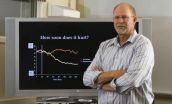(Press-News.org) SALT LAKE CITY—Leukemia is the most common childhood cancer; it also occurs in adults. Now researchers working with zebrafish at Huntsman Cancer Institute (HCI) at the University of Utah have identified previously undiscovered high-risk genetic features in T-cell acute lymphocytic leukemia (T-ALL), according to an article published online May 9, 2011, in the cancer research journal Oncogene. When compared to samples from human patients with T-ALL, these genetic characteristics allowed scientists to predict which patients may have more aggressive forms of the disease that either recur after remission or do not respond to treatment.
While there are several subtypes, in all leukemias the body overproduces certain blood cells that have not matured properly. In this study, the researchers investigated a particular type of leukemia that results from genetic mutations in T-cells, a type of white blood cell found in both humans and zebrafish.
Using a technique called serial transplantation, the research team studied T-ALL in zebrafish and selected cancer cells from those in which the disease advanced more rapidly for further testing. This method allowed the research team to zero in on genes associated with T-ALL's most aggressive forms. They then compared these genetic features to samples from human patients whose clinical outcomes with T-ALL are known.
"We can cure 80% of the children who come to us with leukemia, but there are 20 percent we cannot cure. Sometime the cures come at a high cost to patients in immediate and delayed side effects from chemotherapy," said Nikolaus Trede, M.D., Ph.D., associate professor in the Department of Pediatrics at the University of Utah (U of U) School of Medicine, HCI investigator, and a senior author of the article. "These results may lead to tests that can show which children with the disease need the strongest chemotherapy to overcome their cancer. Children with less aggressive forms of leukemia can be cured with milder chemotherapy that produces fewer side effects, both during treatment and long after treatment is complete."
Kimble Frazer, M.D., Ph.D., assistant professor of pediatrics at the U of U and a member of the Trede Lab, is co-senior author of the article. "One of the genes identified in the study had not previously been recognized as important in T-ALL," said Frazer. "Another gene, associated with patients whose outcomes were least favorable, has not received enough research attention to even have an official name. It only has an 'address' that tells its location on a specific chromosome."
The researchers stress that their results are still preliminary. They plan further laboratory studies to bolster the case that this unnamed gene with the address C7orf60 is important in the development of T-ALL. Additional zebrafish experiments that focus on this gene could be designed to amplify its effects and confirm its contribution to creating more, or hardier, leukemia. In the end, the research could lead to a test that would allow doctors to determine the best course of treatment for an individual leukemia patient by analyzing a blood sample.
Both Trede and Frazer credit the article's first-listed author, Lynnie Rudner, with much of the work leading to the published results. Rudner is the recipient of the American Medical Association (AMA) Foundation's Seed Grant, one of only 38 individuals nationwide who received a seed grant in 2010, and a student in the U of U's M.D./Ph.D. program, which produces graduates qualified in both clinical practice and laboratory research.
###
Other co-authors include researchers from Brigham and Women's Hospital in Boston, Massachusetts, University of Texas at Brownsville, Dana-Farber Cancer Institute and Children's Hospital Boston, and St. Jude Children's Research Hospital in Memphis, Tenn.
This work was supported by funding from the National Institute of Allergy and Infectious Diseases, the Eunice Kennedy Shriver National Institute of Child Health & Human Development, the American Medical Association, Huntsman Cancer Foundation, the Children's Health Research Center at the University of Utah, and Huntsman Cancer Institute core facilities.
The mission of Huntsman Cancer Institute (HCI) at The University of Utah is to understand cancer from its beginnings, to use that knowledge in the creation and improvement of cancer treatments, to relieve the suffering of cancer patients, and to provide education about cancer risk, prevention, and care. HCI is a National Cancer Institute-designated cancer center, which means that it meets the highest national standards for cancer care and research and receives support for its scientific endeavors. HCI is also a member of the National Comprehensive Cancer Network (NCCN) a not-for-profit alliance of the world's leading cancer centers, which is dedicated to improving the quality and effectiveness of care provided to patients with cancer. For more information about HCI, please visit www.huntsmancancer.org.
Zebrafish models identify high-risk genetic features in leukemia patients
Genes predict worst-case scenario
2011-05-11
ELSE PRESS RELEASES FROM THIS DATE:
2 new studies describe likely beneficiaries of health care reform in California
2011-05-11
According to two new policy briefs from the UCLA Center for Health Policy Research, the majority of state residents likely to be eligible for federally mandated health insurance coverage initiatives in California in 2014 are also those who may be least likely to excessively use costly health services: men, singles and those of working age.
As a result of last year's passage of the federal Patient Protection and Affordable Care Act (ACA), up to 4.57 million previously uninsured or underinsured Californians may be eligible for coverage, either through an expansion of ...
Less than half of patients with MS continually adhere to drug therapies for treatment: Study
2011-05-11
TORONTO, Ont., May 11, 2011 — Disease-modifying drugs (DMDs) are injected medications used to slow the progression of multiple sclerosis (MS), and have been shown to reduce the frequency and severity of relapses. But according to a new study led by St. Michael's Hospital and the Institute for Clinical Evaluative Sciences (ICES), adherence to all DMDs is low, with less than half of patients, or 44 per cent, continually adherent after two years.
"There are a number of reasons why adherence to therapies of proven value might be low," says Dr. Paul O'Connor, director of the ...
Harnessing the energy of the Sun: New technique improves artificial photosynthesis
2011-05-11
This discovery will make it possible to improve photoelectrochemical cells. In the same way that plants use photosynthesis to transform sunlight into energy, these cells use sunlight to drive chemical reactions that ultimately produce hydrogen from water. The process involves using a light-sensitive semi-conducting material such as cuprous oxide to provide the current needed to fuel the reaction. Although it is not expensive, the oxide is unstable if exposed to light in water. Research by
Adriana Paracchino and Elijah Thimsen, published May 8, 2011 in the journal Nature ...
Foot and mouth disease may spread through shedding skin cells
2011-05-11
LIVERMORE, Calif. --Skin cells shed from livestock infected with foot and mouth disease could very well spread the disease.
In a new paper appearing in the Proceedings of the Royal Society B, Lawrence Livermore National Laboratory scientist Michael Dillon proposed that virus-infected skin cells could be a source of infectious foot and mouth disease virus aerosols. His proposal is based on the facts that foot and mouth disease virus is found in skin and that airborne skin cells are known to transmit other diseases.
The proposal could lead to new methods for surveillance ...
Doppler effect found even at molecular level – 169 years after its discovery
2011-05-11
CORVALLIS, Ore. – Whether they know it or not, anyone who's ever gotten a speeding ticket after zooming by a radar gun has experienced the Doppler effect – a measurable shift in the frequency of radiation based on the motion of an object, which in this case is your car doing 45 miles an hour in a 30-mph zone.
But for the first time, scientists have experimentally shown a different version of the Doppler effect at a much, much smaller level – the rotation of an individual molecule. Prior to this such an effect had been theorized, but it took a complex experiment with a ...
Tiny talk on a barnacle's back
2011-05-11
Even the merest of microbes must be able to talk, to be able to interact with its environment and with others to not just survive, but to thrive. This cellular chatter comes in the form of signaling molecules and exchanged metabolites (molecules involved in the process of metabolism or living) that can have effects far larger than the organism itself. Humans, for example, rely upon thousands of products derived from microbially produced molecules, everything from antibiotics and food supplements to ingredients used in toothpaste and paint.
Remarkably, most of what's known ...
Win-Win Deal From Halfpricesoft.com Opens Check Writing Software For More Businesses
2011-05-11
Halfpricesoft.com (http://www.halfpricesoft.com) announces that ezCheckPrinting users can get the popular check writing software or blank check stock for free when they check out through TrialPay offer from halfpricesoft.com site.
"It's a win-win-win-win situation: the customer gets free product, we make sales, the TrialPay advertiser makes sales, and TrialPay gets commissions," said Dr Ge, the founder of halfpricesoft.com. "In a down economy, companies need to streamline and increase efficiency, so they can be more productive with every minute and every ...
Study suggests systemic sclerosis is an independent risk factor for atherosclerosis
2011-05-11
A new study by researchers in Hong Kong suggests that systemic sclerosis is an independent determinant for moderate to severe coronary calcification or atherosclerosis. Conventional cardiovascular risk factors such as age and hypertension predispose patients with systemic sclerosis to plaque build-up in the heart arteries similar to the general population. Details of this study are now available in Arthritis & Rheumatism, a journal published by Wiley-Blackwell on behalf of the American College of Rheumatology (ACR).
Systemic sclerosis, also known as scleroderma, is a ...
Razing Seattle's viaduct doesn't guarantee nightmare commutes, model says
2011-05-11
Debate about how to replace Seattle's deteriorating waterfront highway has centered on uncertainties in the project's price tag. Drilling a deep-bore tunnel and building an underground highway is estimated to cost around $4 billion, but some worry the final price could be higher, as it was for Boston's infamous Big Dig.
University of Washington statisticians have, for the first time, explored a different subject of uncertainty, namely surrounding how much commuters might benefit from the project. They found that relying on surface streets would likely have less impact ...
Professor: Pain of ostracism can be deep, long-lasting
2011-05-11
WEST LAFAYETTE, Ind. - Ostracism or exclusion may not leave external scars, but it can cause pain that often is deeper and lasts longer than a physical injury, according to a Purdue University expert.
"Being excluded or ostracized is an invisible form of bullying that doesn't leave bruises, and therefore we often underestimate its impact," said Kipling D. Williams, a professor of psychological sciences. "Being excluded by high school friends, office colleagues, or even spouses or family members can be excruciating. And because ostracism is experienced in three stages, ...
LAST 30 PRESS RELEASES:
Making lighter work of calculating fluid and heat flow
Normalizing blood sugar can halve heart attack risk
Lowering blood sugar cuts heart attack risk in people with prediabetes
Study links genetic variants to risk of blinding eye disease in premature infants
Non-opioid ‘pain sponge’ therapy halts cartilage degeneration and relieves chronic pain
AI can pick up cultural values by mimicking how kids learn
China’s ecological redlines offer fast track to 30 x 30 global conservation goal
Invisible indoor threats: emerging household contaminants and their growing risks to human health
Adding antibody treatment to chemo boosts outcomes for children with rare cancer
Germline pathogenic variants among women without a history of breast cancer
Tanning beds triple melanoma risk, potentially causing broad DNA damage
Unique bond identified as key to viral infection speed
Indoor tanning makes youthful skin much older on a genetic level
Mouse model sheds new light on the causes and potential solutions to human GI problems linked to muscular dystrophy
The Journal of Nuclear Medicine ahead-of-print tip sheet: December 12, 2025
Smarter tools for peering into the microscopic world
Applications open for funding to conduct research in the Kinsey Institute archives
Global measure underestimates the severity of food insecurity
Child survivors of critical illness are missing out on timely follow up care
Risk-based vs annual breast cancer screening / the WISDOM randomized clinical trial
University of Toronto launches Electric Vehicle Innovation Ontario to accelerate advanced EV technologies and build Canada’s innovation advantage
Early relapse predicts poor outcomes in aggressive blood cancer
American College of Lifestyle Medicine applauds two CMS models aligned with lifestyle medicine practice and reimbursement
Clinical trial finds cannabis use not a barrier to quitting nicotine vaping
Supplemental nutrition assistance program policies and food insecurity
Switching immune cells to “night mode” could limit damage after a heart attack, study suggests
URI-based Global RIghts Project report spotlights continued troubling trends in worldwide inhumane treatment
Neutrophils are less aggressive at night, explaining why nighttime heart attacks cause less damage than daytime events
Menopausal hormone therapy may not pose breast cancer risk for women with BRCA mutations
Mobile health tool may improve quality of life for adolescent and young adult breast cancer survivors
[Press-News.org] Zebrafish models identify high-risk genetic features in leukemia patientsGenes predict worst-case scenario



